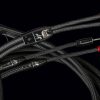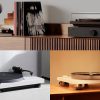Instructions on getting good bass from a subwoofer in any given room usually begin by suggesting corner placement of the subwoofer. And it’s true: placing the subwoofer in a corner will equally energize all the room’s resonances and maximize the subwoofer’s output. However, one of the more bizarre aspects of how subwoofers couple with the specific dimensions of a room — is that to hear all the bass energy from the subwoofer in the corner of your room, you would have to sit in the corner diagonally opposite the subwoofer!
Clearly, such social isolation won’t endear you to family and friends, so compromise is in order. And given the understanding that no room is ideal (not even a room with asymmetrical dimensions), the trick is to combine careful subwoofer and furniture placement (with the possibility of using two subwoofers) to more evenly distribute the deep bass frequencies throughout the room. Then every listener will hear the powerful bass frequencies that bring impact to home theater and music.
As you might suppose, a subwoofer and your particular room work together. It’s not just the location of the subwoofer that matters: where you place the sofa and chairs is just as important. What follows are some subwoofer room-placement basics:
- The worst place for a subwoofer is in the middle of a room.
- The most difficult room shape is square, so if you have the flexibility to choose which room you’ll use for home theater or you are building a new home and designating a space for home theater, avoid rooms with equal dimensions.
- As you move the subwoofer closer to a wall, the bass output will become stronger.
- Bass output will be maximized as you push the subwoofer into a corner.
- The closer you sit to a wall, the more pressure your ear will pick up and the greater the bass intensity will be, but it may become uneven– alternately boomy or anemic as you move in either direction.
- Adjusting the distance of the couch or chairs relative to the walls and/or the subwoofer relative to the corner will almost always be beneficial in helping smooth out the deep bass heard at several listening locations in the room.
- Adding a second subwoofer won’t cure the problem of standing waves or uneven bass, but it will result in a greater number of listeners hearing smoother overall bass in more locations. Try placing the second subwoofer in a location near the wall opposite the first subwoofer.
- Avoid rooms with concrete floors and walls. Walls where the wallboard flexes are more absorptive and produce fewer problems with “bass boom.” If you can’t avoid concrete walls, add studs and one layer of wallboard to the walls of the room to further aid absorption.
Video: How to do the Subwoofer Crawl
Move your subwoofer as close as you can to where you sit. If it’s a chair, move the chair aside and place the sub in the spot where the chair was. If it’s a couch, slide the couch temporarily out of the way and put the sub about where you usually sit.
Play a DVD with lots of low-frequency effects or a CD with plenty of deep bass, the kind that really kicks your sub into serious bass output. Get out the kneepads and crawl about the room in the general area where you were thinking of locating the sub.
Go several yards in each direction–near the wall, out from the wall, towards a corner, away from the corner, and so on–while you listen for smooth and extended deep bass response, free of exaggeration and “one-note” boom. Mark the spot, then move the subwoofer into that position. Now put the furniture back. If you are using two subwoofers, mark two locations and place the subs in those two positions.
The Tech Talk
All subwoofers produce acoustical pressure, and that is what your ear responds to. The only place where you will hear the bass output that your subwoofer produces exclusively is out of doors (or in an anechoic chamber). But soon as you put a subwoofer into a room, the sound waves bounce back and forth between the parallel surfaces of the room, some combining or “adding,” which will emphasize those sounds, and others canceling each other out, which results in a null. If you are sitting in a null, you won’t hear any deep bass at all. Conversely, if your chair is in a location where standing waves peak, you will likely hear boomy, one-note bass (you won’t be able to follow the tuneful bass line of a recording, for example). Sometimes, by just moving a foot or two, the deep bass will “magically” reappear.






























